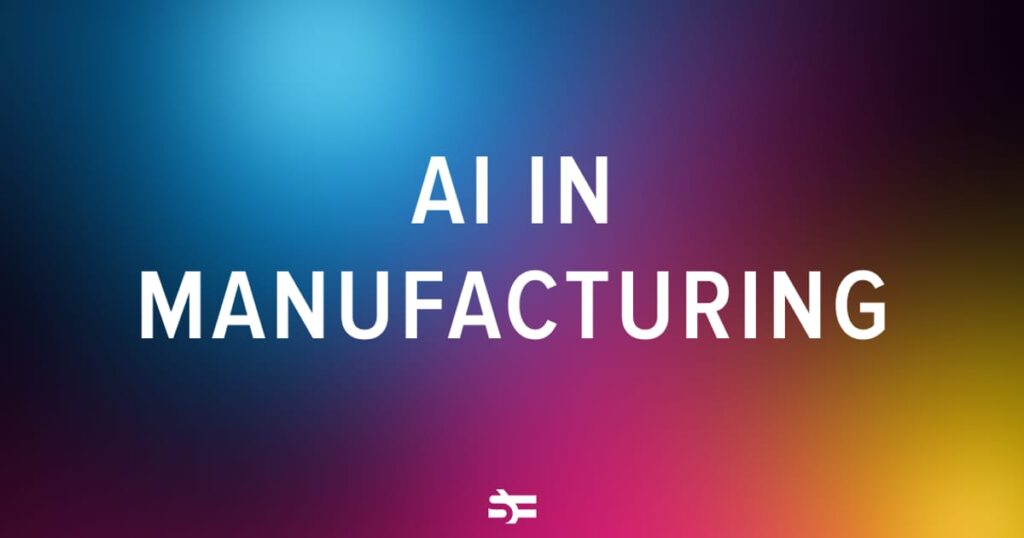This article discusses how AI has revolutionized the manufacturing industry by automating routine tasks and reducing operational costs. We will explore some of the most promising use cases and examine the opportunities and challenges of implementing AI.
The state of AI adoption in manufacturing
The global market for artificial intelligence in manufacturing was valued at US $17.5 billion in 2022 and is expected to reach US $267.3 billion by 2030, growing at a rate of 40.6% annually from 2024 to 2030.
According to Deloitte, the manufacturing sector is projected to generate approximately 1,812 petabytes (PB) of data each year, surpassing other industries like communications, finance, and retail.
The rising demand for AI in the American manufacturing sector is driven by the need to handle increasing production volumes and data complexity efficiently. This trend is further reinforced by the adoption of advanced manufacturing technologies and Industry 4.0 principles, as well as the transition to smart factories.
In Europe, the robotics market is experiencing significant growth across various sectors, supported by government initiatives. There is also a strong collaboration between universities and businesses focused on innovation.
Key areas of AI implementations in manufacturing
AI is being applied in key areas of manufacturing such as predictive maintenance, product development, quality inspection, and supply chain management.
Predictive maintenance: AI algorithms analyze data from equipment sensors to predict failures before they occur, reducing repair costs, minimizing downtime, and extending equipment lifespan.
- Companies like BASF and Duke Energy Renewables have implemented predictive maintenance to improve equipment reliability and performance.
Product development: AI is being used to accelerate product development and reduce costs associated with bringing new products to market.
- Companies like Unilever and Procter & Gamble are using AI to streamline product development processes.
Quality inspection: AI-driven visual inspection systems are transforming quality control processes by detecting defects more accurately and quickly than human inspectors.
- Companies like AB InBev and Mars are using AI to enhance quality control in their manufacturing processes.
Supply chain management: AI integration in supply chain management is helping manufacturers address warehousing and transportation challenges more efficiently.
- Companies like subsidiaries of Koch Industries are using AI to streamline supply management processes.
Demand planning and pricing: Machine learning algorithms are being used to predict future demand accurately, optimize production schedules, and reduce inventory costs.
- Companies like Danone have implemented machine learning systems to improve demand forecasting and planning processes.
How AI adoption helps overcome production challenges
Manufacturers are increasingly incorporating AI across all production stages and operational processes to enhance efficiency. Below are some examples of companies leveraging AI in their manufacturing processes.
Schaeffler
Schaeffler AG utilizes the Siemens Industrial Copilot, an AI-powered assistant, to optimize industrial automation systems and enhance human-machine cooperation.
General Motors
General Motors has implemented machine learning systems to improve prototyping efficiency and detect early signs of component failure on the assembly line.
Bridgestone
Bridgestone uses AI in its tire assembly technology to optimize production processes and ensure quality control.
This system not only improves accuracy but also doubles efficiency.
Bridgestone’s Virtual Tyre Development technology is a prime example of AI application in action. Through the use of digital tire models designed and tested virtually, this approach saves approximately 200 tires per project, leading to a significant reduction in raw material usage and CO2 emissions during the development phase. Additionally, it enables the testing of more tire variants, cuts product development time and outdoor fleet tire tests by up to 50%, ultimately reducing time to market and costs.
ABB
In 2022, ABB introduced its smallest industrial robot yet, the IRB 1010, revolutionizing smart wearable device manufacturing. With its compact size, high carrying capacity, and exceptional precision, electronics producers were able to enhance their production of various devices through automation, including watches, earbuds, sensors, and fitness trackers.
This section delves into some of the most promising AI-driven technologies reshaping the manufacturing industry. While generative design, collaborative robots (cobots), and lights-out factories are gradually being integrated into manufacturing processes, they are expected to become more prevalent in the near future.
Generative design
Generative design, akin to generative AI tools like ChatGPT and Dall-E, focuses on product design. By inputting specific requirements such as materials, dimensions, weight, manufacturing methods, and cost, design engineers can generate numerous design options for new products. These options are then evaluated to select the most suitable for production, significantly expediting the development cycle.
Particularly impactful in 3D printing, generative design excels in creating intricate shapes and structures. This has led to the production of cost-effective, lightweight, and strong components, enhancing product quality and efficiency across industries like automotive, aerospace, and construction.
Cobots
Collaborative robots, or cobots, complement human workers by providing additional support. Unlike autonomous robots with fixed tasks, cobots can learn various tasks and navigate workspaces safely alongside humans. In industries like automotive, cobots assist in lifting heavy components for assembly, while in warehouses, they efficiently locate and retrieve items.
Lights-out factories
Lights-out factories represent the pinnacle of manufacturing automation, where production occurs without human intervention, enabling a continuous 24/7 cycle. Leveraging advanced robotics, AI, and machine learning, these factories manage tasks from assembly to quality control and packaging.
Conclusion
The future of AI holds promise for robots that can adapt to diverse tasks with minimal training. Efforts are underway to develop AI that can generalize learning across domains, resembling human learning. Manufacturers are urged to establish AI development divisions or collaborate with experts for innovative ideas and strategies.
Early adopters of AI are poised to reap significant benefits compared to followers in terms of cash flow and competitiveness.
For further insight into AI adoption, refer to:
AI Integration in Oil and Gas


